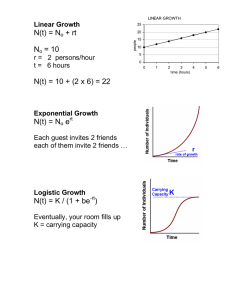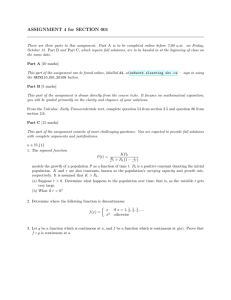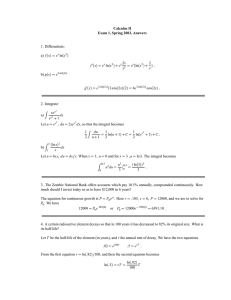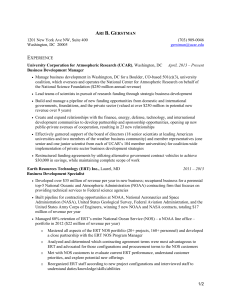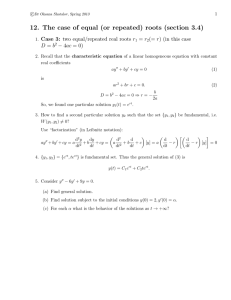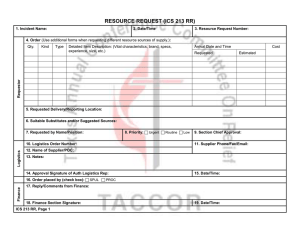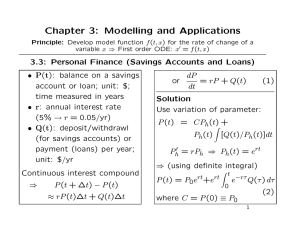12. Resonance and the exponential ... 12.1. Exponential shift. The calculation (10.1) (1)
advertisement
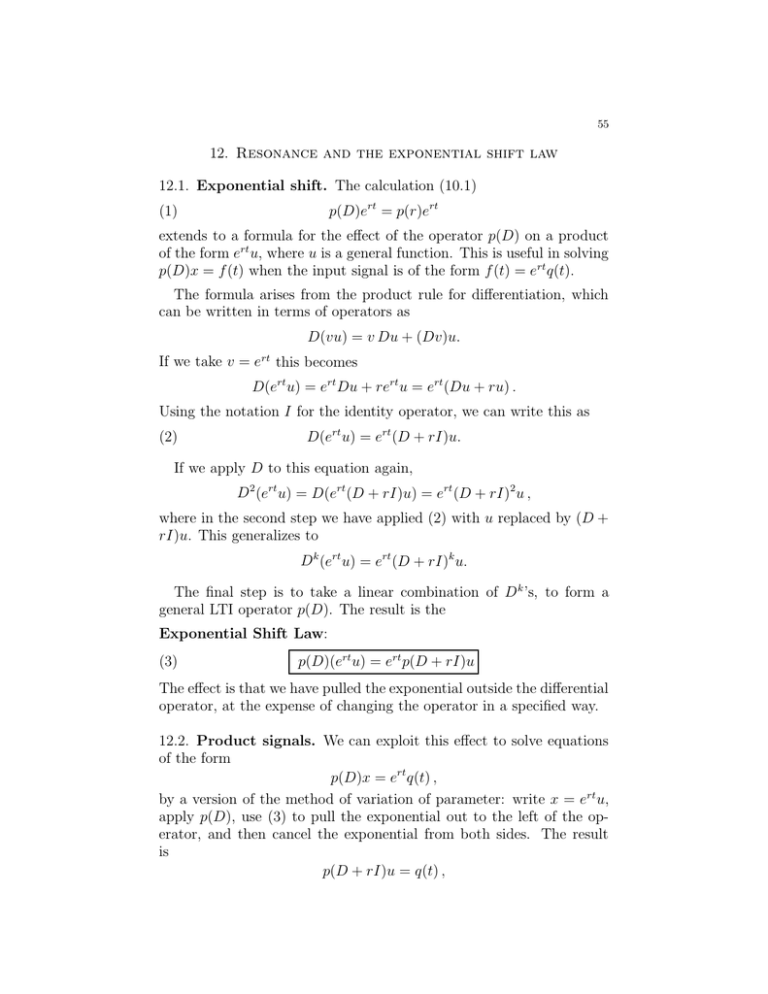
55 12. Resonance and the exponential shift law 12.1. Exponential shift. The calculation (10.1) p(D)ert = p(r)ert (1) extends to a formula for the effect of the operator p(D) on a product of the form ert u, where u is a general function. This is useful in solving p(D)x = f (t) when the input signal is of the form f (t) = ert q(t). The formula arises from the product rule for differentiation, which can be written in terms of operators as D(vu) = v Du + (Dv)u. If we take v = ert this becomes D(ert u) = ert Du + rert u = ert (Du + ru) . Using the notation I for the identity operator, we can write this as (2) D(ert u) = ert (D + rI)u. If we apply D to this equation again, D 2 (ert u) = D(ert (D + rI)u) = ert (D + rI)2 u , where in the second step we have applied (2) with u replaced by (D + rI)u. This generalizes to D k (ert u) = ert (D + rI)k u. The final step is to take a linear combination of D k ’s, to form a general LTI operator p(D). The result is the Exponential Shift Law: (3) p(D)(ert u) = ert p(D + rI)u The effect is that we have pulled the exponential outside the differential operator, at the expense of changing the operator in a specified way. 12.2. Product signals. We can exploit this effect to solve equations of the form p(D)x = ert q(t) , by a version of the method of variation of parameter: write x = ert u, apply p(D), use (3) to pull the exponential out to the left of the op­ erator, and then cancel the exponential from both sides. The result is p(D + rI)u = q(t) , 56 a new LTI ODE for the function u, one from which the exponential factor has been eliminated. Example 12.2.1. Find a particular solution to ẍ + ẋ + x = t2 e3t . With p(s) = s2 + s + 1 and x = e3t u, we have ẍ + ẋ + x = p(D)x = p(D)(e3t u) = e3t p(D + 3I)u . Set this equal to t2 e3t and cancel the exponential, to find p(D + 3I)u = t2 or u̇ + 3u = t2 . This is a good target for the method of undetermined coefficients (Section 11). The first step is to compute p(s + 3) = (s + 3)2 + (s + 3) + 1 = s2 + 7s + 13 , so we have ü + 7u̇ + 13u = t2 . There is a solution of the form up = at2 + bt + c, and we find it is up = (1/13)t2 − (14/132 )t + (85/133 ) . Thus a particular solution for the original problem is xp = e3t ((1/13)t2 − (14/132 )t + (85/133 )) . Example 12.2.2. Find a particular solution to ẋ + x = te−t sin t. The signal is the imaginary part of te(−1+i)t , so, following the method of Section 10, we consider the ODE ż + z = te(−1+i)t . If we can find a solution zp for this, then xp = Im zp will be a solution to the original problem. We will look for z of the form e(−1+i)t u. The Exponential Shift Law (3) with p(s) = s + 1 gives ż + z = (D + I)(e(−1+i)t u) = e(−1+i)t ((D + (−1 + i)I) + I)u = e(−1+i)t (D + iI)u. When we set this equal to the right hand side we can cancel the expo­ nential: (D + iI)u = t or u̇ + iu = t. While this is now an ODE with complex coefficients, it’s easy to solve by the method of undetermined coefficients: there is a solution of the form up = at + b. Computing the coefficients, up = −it + 1; so zp = e(−1+i)t (−it + 1). Finally, extract the imaginary part to obtain xp : zp = e−t (cos t + i sin t)(−it + 1) 57 has imaginary part xp = e−t (−t cos t + sin t). 12.3. Resonance. We have noted that the Exponential Response For­ mula for a solution to p(D)x = ert fails when p(r) = 0. For example, For example, suppose we have ẋ + x = e−t . The Exponential Response Formula proposes a solution xp = e−t /p(−1), but p(−1) = 0 so this fails. There is no solution of the form cert . This situation is called resonance, because the signal is tuned to a natural mode of the system. Here is a way to solve p(D)x = ert when this happens. The ERF came from the calculation p(D)ert = p(r)ert , which is valid whether or not p(r) = 0. We will take this expression and differentiate it with respect to r, keeping t constant. The result, using the product rule and the fact that partial derivatives commute, is p(D)tert = p→ (r)ert + p(r)tert If p(r) = 0 this simplifies to (4) p(D)tert = p→ (r)ert . Now if p→ (r) = ∈ 0 we can divide through by it and see: The Resonant Exponential Response Formula: If p(r) = 0 then a solution to p(D)x = aert is given by (5) xp = a tert p→ (r) provided that p→ (r) = ∈ 0. In our example above, p(s) = s + 1 and r = 1, so p→ (r) = 1 and xp = te−t is a solution. This example exhibits a characteristic feature of resonance: the solu­ tions grow faster than you might expect. The characteristic polynomial leads you to expect a solution of the order of e−t . In fact the solution is t times this. It still decays to zero as t grows, but not as fast as e−t does. Example 12.3.1. Suppose we have a harmonic oscillator represented by ẍ + �n2 x, or by the operator D 2 + �n2 I = p(D), and drive it by the 58 signal a cos(�t). This ODE is the real part of z̈ + �n2 z = aei�t , so the Exponential Response Formula gives us the periodic solution zp = a ei�n t . p(i�) This is fine unless � = �n , in which case p(i�n ) = (i�n )2 + �n2 = 0; so the amplitude of the proposed sinusoidal response should be infinite. The fact is that there is no periodic system response; the system is in resonance with the signal. To circumvent this problem, let’s apply the Resonance Exponential Response Formula: since p(s) = s2 + �n2 , p→ (s) = 2s and p→ (i�n ) = 2i�0 , so tei�n t zp = a . 2i�n The real part is a xp = t sin(�n t) . 2�n The general solution is thus a x= t sin(�n t) + b cos(�n t − π) . 2�n In words, all solutions oscillate with pseudoperiod 2ν/�n , and grow in amplitude like at/(2�n ). When �n is large—high frequency—this rate of growth is small. 12.4. Higher order resonance. It may happen that both p(r) = 0 and p→ (r) = 0. The general picture is this: Suppose that k is such that p(j) (r) = 0 for j < k and p(k) (r) = ∈ 0. Then p(D)x = aert has as solution tk ert (6) xp = a (k) . p (r) For instance, if � = �0 = 0 in Example 12.3.1, p→ (i�) = 0. The signal is now just the constant function a, and the ODE is ẍ = a. Integrating twice gives xp = at2 /2 as a solution, which is a special case of (6), since ert = 1 and p→→ (s) = 2. You can see (6) in the same way we saw the Resonant Exponential Response Formula. So take (4) and differentiate again with respect to r: p(D)t2 ert = p→→ (r)ert + p→ (r)tert 59 If p→ (r) = 0, the second term drops out and if we suppose p→→ (r) = ∈ 0 and divide through by it we get � 2 rt ⎨ t e p(D) → = ert p (r) which the case k = 2 of (6). Continuing, we get to higher values of k as well. 12.5. Summary. The work of this section and the last can be sum­ marized as follows: Among the responses by an LTI system to a signal which is polynomial times exponential (or a linear combination of such) there is always one which is again a linear combination of functions which are polynomial times exponential. By the magic of the complex exponential, sinusoidal factors are included in this. MIT OpenCourseWare http://ocw.mit.edu 18.03 Differential Equations���� Spring 2010 For information about citing these materials or our Terms of Use, visit: http://ocw.mit.edu/terms.
